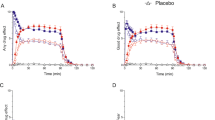Abstract.
Rationale: Buspirone is used as a neuroendocrine challenge in which the increase of circulating prolactin is taken as a measure of the sensitivity of central serotonergic (5-HT1A) pathways. Interpretation of the test is complicated, however, by the fact that buspirone possesses D2 antagonist and 5-HT1A agonist activity, both of which will result in the release of prolactin. To understand the significance of prolactin secretion in response to buspirone, it is important to measure the differential actions of the two controlling pathways. Objective: To characterise the dual action of buspirone in stimulating the secretion of prolactin by blocking the 5-HT1A action with the 5-HT1A antagonist action of pindolol. Methods: Healthy male subjects (n=35) received buspirone (0.5 mg·kg bw–1 orally) with and without pre-treatment with the 5-HT1A receptor antagonist pindolol (40 mg over 2 days, 0.5 mg·kg bw–1 on test day). Nine subjects underwent two additional trials in which they received a placebo with and without pre-treatment with pindolol. Results: Pindolol alone caused a small but significant reduction (18%) in the tonic release of prolactin. Buspirone alone produced a robust prolactin response which was reduced to approximately half by pindolol pre-treatment. Pindolol pre-treatment also, on average, delayed the onset and peak of the prolactin response. There was wide variation among individuals both in the absolute response to buspirone and in the proportion that could be attributed to the non-serotonergic agonist action of buspirone (22–82% IQ range). Conclusions: Our results indicate that while serotonergic pathways play a minor role in the tonic release of prolactin, the response to a buspirone challenge alone cannot be used as a simple index of central serotonergic activity. However, if two challenges are carried out, one with buspirone and the other with buspirone plus pindolol, quantitative measures can be made of the sensitivity of both the 5-HT1A and the putative D2 pathways controlling prolactin release.
Similar content being viewed by others
Author information
Authors and Affiliations
Additional information
Electronic Publication
Rights and permissions
About this article
Cite this article
Bridge, .M., Marvin, .G., Thompson, .C. et al. Quantifying the 5-HT1A agonist action of buspirone in man. Psychopharmacology 158, 224–229 (2001). https://doi.org/10.1007/s002130100881
Received:
Accepted:
Issue Date:
DOI: https://doi.org/10.1007/s002130100881




